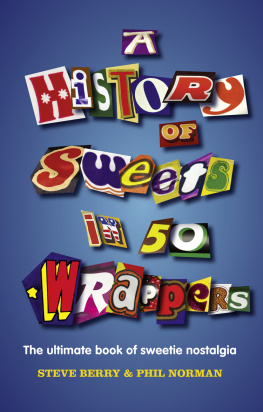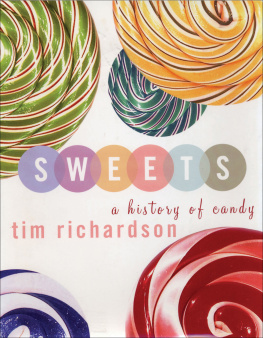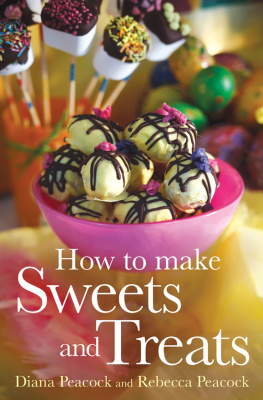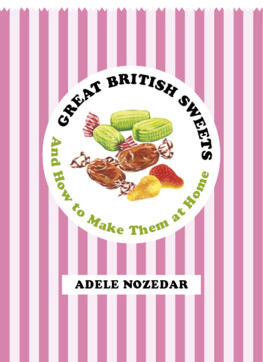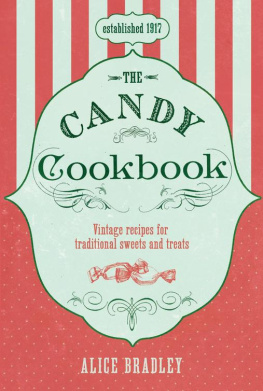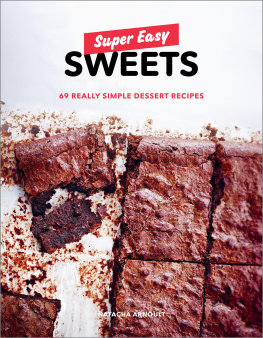Louis Barfe, Andy Blackford, Norton Canes, Paul Dennis, Sarah-Louise Heslop, Roger McKechnie, Rob McKoen, James Nichols, Jon Peake, Nicholas Pegg, Whitby Specialist Vehicles Limited.
Rachel Faulkner, Luana Gobbo, Corinna Harrod, Scott Pack, Liam Relph, Clarissa San Pedro.
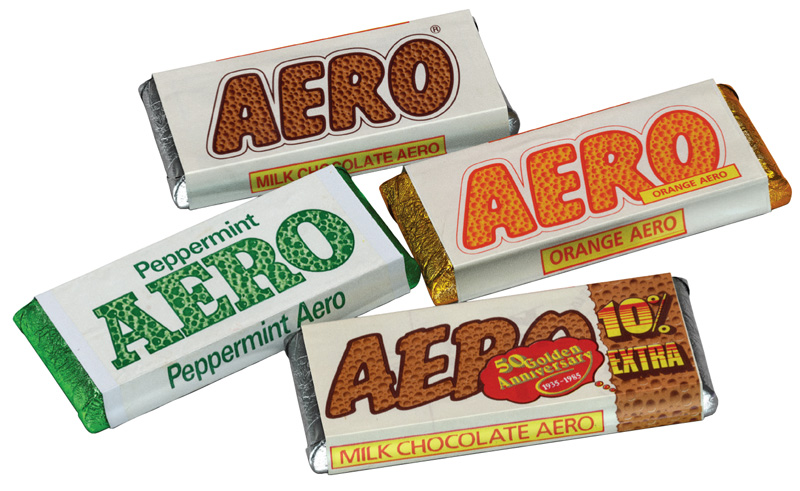
Unforgettabubble, thats what you are. Unforgettabubble, milk chocolate bar. A line of old King Cole for Rowntrees Aero (1935).
For all the Wonka-esque mystique affected by chocolate makers, most confectionery innovations amount to lets bung this on top of this, stick some chocolate on it. The invention of the Aero, however, really did involve science. Rowntrees technicians frothed up some liquid chocolate with a whisk, poured it into moulds and then the clever bit reduced the surrounding air pressure drastically so the tiny bubbles of froth swelled up to a decent size. Then it was a matter of passing the moulds through ice-cold water to set, covering the result with a layer of solid chocolate, and the job was done.
It caused a sensation when it came out, albeit one helpfully whipped up by Rowntree themselves. The exciting new texture, they claimed, stimulates the enzyme glands a bit of shameless quackery they were soon forced to take back. Initially great sales began to tail off, in part due to an assortment of rivals appearing on the scene with undue haste, in particular Frys two tryouts, the Ripple and the All-Chocolate Crunchie. Add to that a disputed patent, and things got panicky at Rowntree headquarters. Fruit and nut and whole nut variants were hurriedly bunged out to support the ailing novelty. Sales levelled off after a while, and the Aero, while no longer a craze, remained steady-as-she-goes.
They couldnt resist mucking about, though. An Aero Wafer introduced in 1950 didnt hang about too long, but in 59 the bright idea of changing the aerated centre from chocolate to peppermint gave the bar a new lease of life, and with orange and coffee centres arriving over the next couple of years, a nice little family was built up that would tick over happily for decades, with just a new campaign based around the word bubbles knocked out every few years. Oh, and a short-lived lime variant in 1971.
Then, cometh the 80s, cometh the Cadburys Wispa. Big trouble in Rowntreeland as the potential Aero spoiler was worriedly picked over. Luckily the two-year gestation period Cadbury took to get the Wispa going nationwide allowed Rowntree to remake the Aero in its image. By September of 1982, gone was the six-segmented flat format, a bumpy chocolate version of the traffic-calming measures in a well-to-do Cotswold village. In came the handy ingot size. In the process, something no one was quite sure what changed. The chocolate had become softer. No, the bubbles were bigger. No, its the taste... It scarcely mattered, as the new bar more than held its own against the Bournville parvenu. But even today, plenty of former stalwart Aerovians feel slighted by the changes, their enzyme glands no longer stimulated in quite the same way.

A sign of civilisation. Aztec (1967), swiftly sacrificed to the gods of chocolate nostalgia.
This is a tale of two cultural cornerstones. On the one hand, the mighty Quetzalcoatl, feathered serpent god of the ancient Aztecs, who gave his people the sacred gift of chocolate via a beam of heavenly light, bringing them universal wisdom and Type 2 diabetes. (Sadly, the one bit of knowledge that might have been some use, namely If you see these Spanish blokes with big shiny helmets, run like the clappers, slipped the feathered ones mind.) In the blue corner, theres the equally legendary rival to the Mars bar, opportunistically cooked up by Cadbury in a lean period and promoted with a travelogue-swish TV campaign filmed at one of your actual Mexican temples, only to vanish mysteriously four years later. The former lived on for centuries in folk memory and overpriced Acapulco gift shops. The latter enjoyed a similarly fertile afterlife, becoming the de facto nostalgic touchstone for the first wave of alternative comedians (Ben Eltons swing-top bin was so long unemptied it had Aztec wrappers in the bottom).
Its perhaps fair to say that Eltons championing of fair-trade didnt tally too well with the Aztecs imperialistic undertones, a state of affairs not helped by the life-size cardboard warrior chieftains installed in newsagents the nation over, to the innocent delight of kids whod gleefully perform a culturally inaccurate whooping war dance around them. All this happened, of course, while the Milky Bar kid was doing his bit for the Native North Americans. To complete the continental clean sweep, the 1980s, when youd have thought people would have calmed down a bit, saw the launch of the otherwise unremarkable Rowntrees Inca. We could, of course, all be very smart and ironic about such things by the time the Aztec made the slightest of slight returns in the year 2000.
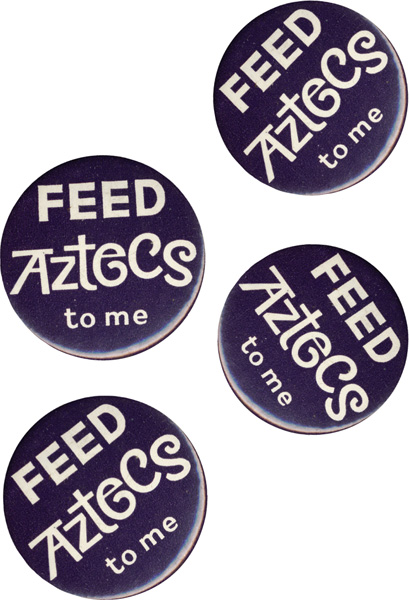
Instigating a Mexican crave. Safety-pin propaganda on behalf of Cadbury.
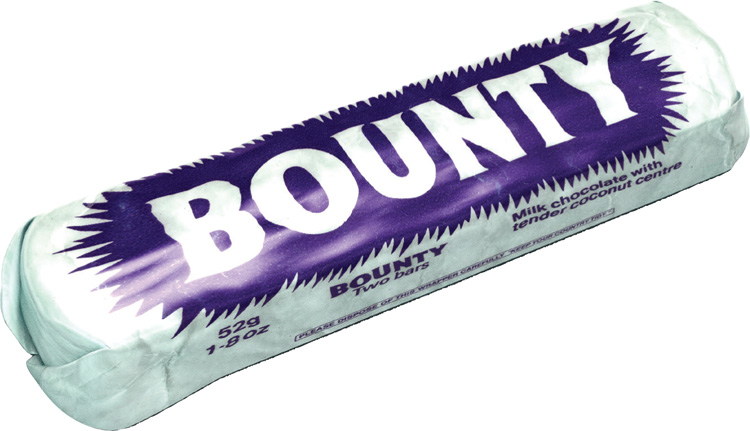
Dessications what you need. Bounty (1951).
There was always something indefinably odd about the Bounty. It wasnt the bar itself. Tender coconut, moist with pure syrup, lavish with thick chocolate. Nothing unusual about that. Wed been here before in 1950, with Rowntrees ill-fated Cokeroon bar. Maybe its the way the Bounty featured two bars in one pack, without making a song and dance about it. Always suspicious when a chocolate bar keeps something like that to itself. And the way it did it not side by side, but in series, with a little jerry-built piece of black waxed cardboard guttering underneath to take up the inevitable slack, leading uncertain youngsters with fond memories of the rice paper on the bottoms of macaroons to try to digest the whole thing. All most irregular.
Then there were the adverts. A Taste of Paradise had been around since the mid-60s, and was fairly self-explanatory. Coconut = tropical. Dead posh, like. Fair enough. The problems began in 1977, with the Bounty hunters TV campaign, showing a weird tribe of well-groomed, lightly tanned Caucasians lounging about on a tropical island somewhere, having left civilisation behind. How could they look that good out there? Especially when they existed entirely on Bountys?
Not only that, they made the bars themselves. Somehow. We saw a coconut being deftly cleft in twain. Then a sheaf of perfectly wrapped bars floated down a limpid stream on a raft of palm leaves, for the tribes womenfolk to pick out and chew absent-mindedly under a waterfall. The intervening stages of manufacture were missing. Where were the grunts shredding the coconut? How did they get hold of the syrup? Whither the glycerol processing plant? And the guttering mystery remained. Worse still, the original flute-led musical backing from Howard The Snowman Blake now featured scene-setting lyrics. The Bow-own-tee-hee HUN-ters, are here/Theyre searching for PAR-a-dise... trilled a woman who sounded constantly worried shed chosen a falsetto too high to sustain. This explained nothing.
After 1978, this fair-trade wonder had to compete with the Rowntrees Cabana, which added caramel and chopped glac cherries to the coconut mix, testing the retentive powers of even the strongest stomach. So they made attempts to assimilate into the real world, acquiring catamarans and scuba gear and moving into the more general sun-kissed lifestyle aspirational bracket loved by lazy Martini account holders and Duran Duran. Structural improvements in wrapper engineering rendered the guttering redundant. The tremulous falsetto became a schmaltzy cover of Try a Little Tenderness. The message was: Hey, its okay! Were not strange at all any more! Nevertheless, the Bounty is still looked at askance by your average British consumer. Still, it could have been worse: in America its called Mounds.

